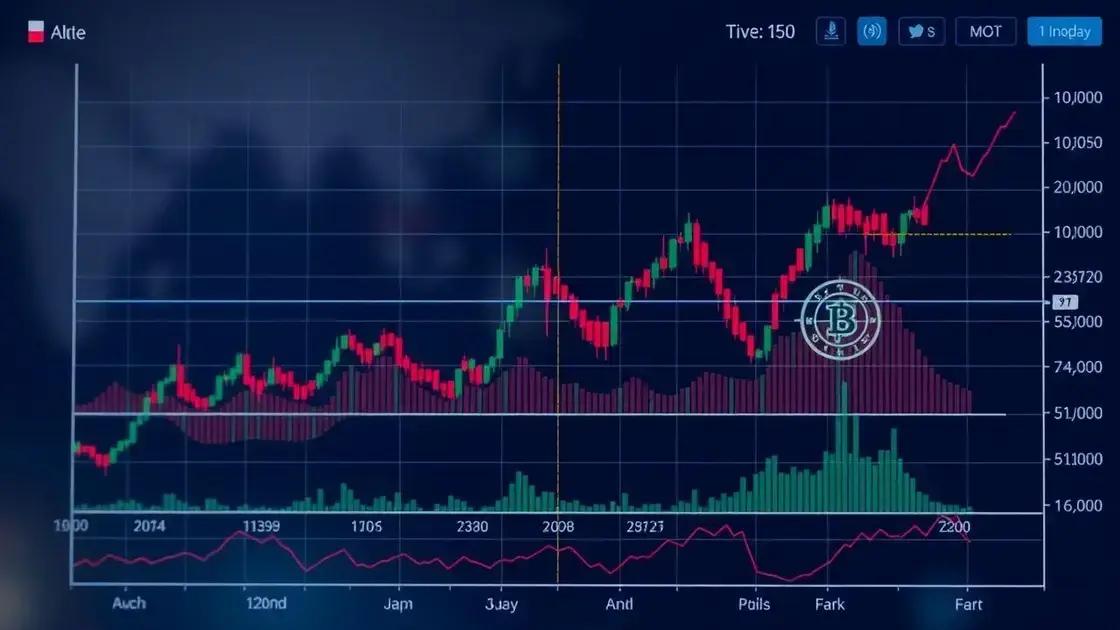April 2025 financial volatility prompts investor concern

Anúncios
April 2025 financial volatility prompts investor concern, driven by economic indicators, geopolitical events, and technological changes, highlighting the need for diversification and proactive risk management strategies.
April 2025 has brought a wave of uncertainty in global markets, as April 2025 financial volatility prompts investor concern. What does this mean for your investments? Let’s dive in.
Anúncios
Understanding the causes of financial volatility
Understanding the causes of financial volatility is crucial for every investor. It helps in navigating uncertain markets. Many factors contribute to this volatility, leading to fluctuations in investments.
Economic Factors
Economic indicators play a significant role in financial volatility. When data is released, it can lead to sharp price movements. It’s essential to pay attention to reports like GDP growth and unemployment rates.
Anúncios
- Interest Rates: Changes in interest rates can affect borrowing costs, influencing investment behaviors.
- Inflation: Rising inflation may lead to reduced consumer spending and affect corporate profits.
- Employment Reports: Job growth or losses can significantly impact market sentiment.
Geopolitical events also stir financial volatility. Events like trade disputes or elections can create uncertainty. Investors often react strongly to news from around the world, leading to quick changes in the market.
Market Psychology
The psychology of investors is another key aspect. Fear and optimism drive market movements. When investors are uncertain, they tend to sell off assets, driving prices down. Understanding this behavior can help mitigate risks.
Moreover, technological advances have led to increased trading speeds. Algorithmic trading responds to market changes almost instantly, contributing to volatility. This rapid response can sometimes exaggerate market movements.
Natural Disasters and Crises
Events such as natural disasters can have immediate effects on specific sectors. Supply chain disruptions often lead to shortages, affecting stock prices. Understanding these impacts is essential for creating a robust strategy.
- Pandemics: Recent global health crises have shown how quickly markets can shift.
- Environmental Factors: Climate change can affect commodity prices and investment strategies.
- Social Unrest: Protests and political instability can impact business operations, leading to decreased investor confidence.
Being aware of these factors helps investors prepare for potential fluctuations. Awareness of the underlying causes of financial volatility can aid in timely decision-making.
How market trends affect investor behavior
Market trends play a significant role in shaping investor behavior. Understanding how these trends impact decisions is vital for navigating the financial landscape. Investors often react to trends in a way that can influence overall market dynamics.
Impact of Bull and Bear Markets
In a bull market, optimism prevails. Investors are eager to buy, believing stocks will continue to rise. This positive sentiment can create a feedback loop, driving prices even higher. Conversely, during bear markets, fear often takes over. Investors sell their holdings to minimize losses, leading to further declines.
- Investor Confidence: High confidence can lead to increased spending and new investments.
- Media Influence: News coverage can amplify emotions, impacting decisions.
- Historical Trends: Past performance can guide future expectations, influencing buying or selling.
Additionally, behavioral finance shows that emotions significantly sway investor behavior. For example, fear of missing out (FOMO) may drive individuals to invest aggressively, while loss aversion can make them hesitant to sell when the market drops.
Technical Analysis and Its Role
Many investors use technical analysis to gauge market trends. This method involves studying price movements, volume, and chart patterns. It helps in predicting future movements based on historical data. If patterns indicate an upward trend, investors may jump in to capitalize on the momentum.
Trends can also lead to herd behavior, wherein investors follow the crowd, often ignoring fundamental analysis. This behavior can create bubbles or amplify downturns.
The Long-term Perspective
In contrast, long-term investors often focus less on short-term fluctuations. They tend to stick to their strategies despite market volatility. This disciplined approach can help in overcoming emotional reactions driven by market trends.
- Diversification: Spreading investments can reduce risk during trend fluctuations.
- Staying Informed: Understanding market conditions helps in making timely decisions without panic.
- Regular Review: Assessing investment strategies periodically helps in adapting to changing trends.
By recognizing how market trends affect investor behavior, individuals can make more informed choices in their investment journey.
Strategies for managing risk during volatility

Managing risk during market volatility is crucial for investors. With unpredictable price swings, having a solid strategy can help protect your finances. Different approaches can help reduce the impact of sudden market changes.
Diversification
Diversification is a key strategy to mitigate risk. By spreading your investments across various asset classes, you can decrease the likelihood of large losses. This approach ensures that if one investment underperforms, others may still thrive.
- Asset Classes: Include stocks, bonds, and real estate in your portfolio to balance risk.
- Geographical Diversity: Invest in international markets to reduce local market dependencies.
- Sector Diversification: Invest in different industries to minimize sector-specific risks.
In addition to diversification, having a clear risk management plan is essential. Knowing how much risk you are willing to take allows you to make informed decisions about your investments. Establishing targets for acceptable loss can guide your trading choices.
Use of Stop-Loss Orders
Stop-loss orders are vital tools during periods of heightened volatility. These orders automatically sell your stocks when they reach a specified price. This helps in minimizing losses and provides peace of mind.
Implementing stop-loss orders ensures you do not have to watch the market constantly. This strategy can help maintain your emotional stability and prevent panic selling.
Staying Informed
Knowledge is power in managing risk. Staying informed about market trends and economic indicators can help you make better decisions. Regularly reviewing your investment strategy ensures you adjust to changing conditions.
- Financial News: Follow market reports and economic updates that could influence your investments.
- Investment Tools: Utilize investing apps or tools that provide real-time data on your portfolio.
- Network and Research: Engage with other investors and conduct thorough research to gain insights.
In the face of financial volatility, flexibility is essential. Being open to adjusting your strategies allows you to react effectively to market conditions. Recognizing when to hold and when to adjust your approach can determine your success as an investor.
The importance of diversification in your portfolio
The importance of diversification in your portfolio cannot be overstated. Having a mix of different investments helps reduce risk and improves the potential for returns. By spreading your investments across various asset classes, you can protect yourself from market fluctuations.
What is Diversification?
Diversification means not putting all your eggs in one basket. Instead of investing in just one stock or asset, you include various types of investments. This strategy helps balance your portfolio, as different assets often perform differently in changing market conditions.
- Types of Investments: Stocks, bonds, real estate, and commodities can all play a role in a balanced portfolio.
- Risk Management: When one asset class is down, others may be up, which helps stabilize your overall investment.
- Long-term Growth: Diversifying can lead to consistent growth over time rather than large swings in value.
Furthermore, diversification isn’t just about having multiple stocks. It’s about having a blend of different assets that respond differently to economic changes. For example, equities may perform well during economic growth, while bonds can provide stability during downturns.
How to Diversify Your Portfolio
There are several ways to achieve diversification. First, consider investing in index funds or mutual funds. This can automatically give you exposure to many different stocks or bonds. Another strategy is to include international investments in your portfolio.
Lastly, remember to regularly review and rebalance your portfolio. As markets change, you may find that some investments have grown faster than others. Adjusting your portfolio regularly helps maintain your desired level of risk and potential return.
- Rebalancing: Ensure that your asset allocation stays in line with your investment goals.
- Sector Exposure: Invest across different industries to avoid concentration risk.
- Geographic Diversification: Consider international markets to enhance your portfolio’s potential.
In summary, understanding and embracing the importance of diversification in your portfolio can lead to better investment outcomes. By avoiding reliance on a single investment, you can minimize risks and potentially enhance returns over time.
Predictions for the financial landscape ahead
Predictions for the financial landscape ahead can help investors navigate uncertain times. By analyzing trends and economic indicators, we can gain insight into what may happen in the coming months and years. This knowledge can help you make more informed investment decisions.
Current Economic Indicators
Key economic indicators provide a glimpse into potential future market movements. Indicators such as inflation rates, unemployment figures, and consumer spending are essential in assessing economic health. A rising inflation rate may lead to higher interest rates, which could impact stock prices.
- Inflation Trends: Higher inflation can decrease purchasing power, affecting consumer behavior.
- Employment Rates: Low unemployment typically boosts spending and economic growth.
- Gross Domestic Product (GDP): GDP growth indicates a healthy economy, influencing investor confidence.
Moreover, geopolitical events can significantly impact market predictions. Trade agreements, political changes, and international conflicts play a crucial role in shaping the financial landscape. Investors should stay alert to these developments as they can lead to volatility in the markets.
Technological Advances
Technological advancements continue to transform the financial sector. Innovations in fintech, blockchain, and artificial intelligence are changing how people invest and manage their money. These advancements may provide new opportunities and risks in the market.
As technology evolves, investors must adapt to potential shifts in their strategies. For example, the rise of cryptocurrencies has introduced new asset classes, which carry different levels of risk and reward.
Market Sentiment and Behavioral Trends
Understanding market sentiment is critical for predicting future movements. Investor psychology often drives market trends, and emotions like fear and greed can lead to abrupt changes in stock prices. Keeping an eye on consumer sentiment surveys and market volatility indexes can provide insights into how investors feel about the market’s direction.
- Fear and Greed Index: A tool that gauges market sentiment and investor behaviors can help predict trends.
- Consumer Confidence Index: High confidence can signal increased spending and investment.
- Behavioral Economics: Understanding how emotions influence decisions can improve investment strategies.
Incorporating these predictions about the financial landscape ahead into your investment approach can help you navigate challenges and seize opportunities. By staying informed about economic indicators, technological advancements, and market sentiment, you are better prepared to adjust your strategies as necessary.
FAQ – Frequently Asked Questions about Financial Volatility and Investments
What is financial volatility?
Financial volatility refers to the degree of variation in trading prices over time, indicating how much the price of an asset can change.
How does diversification help reduce risk?
Diversification spreads your investments across various assets, lowering the risk that a poor performance in one investment will significantly affect your overall portfolio.
What are key indicators to watch for in the market?
Key indicators include inflation rates, employment statistics, and GDP growth, which can provide insight into economic health and potential market movements.
Why is staying informed important for investors?
Staying informed helps investors make better decisions based on current trends, market sentiment, and economic conditions, allowing for more effective strategy adjustments.






